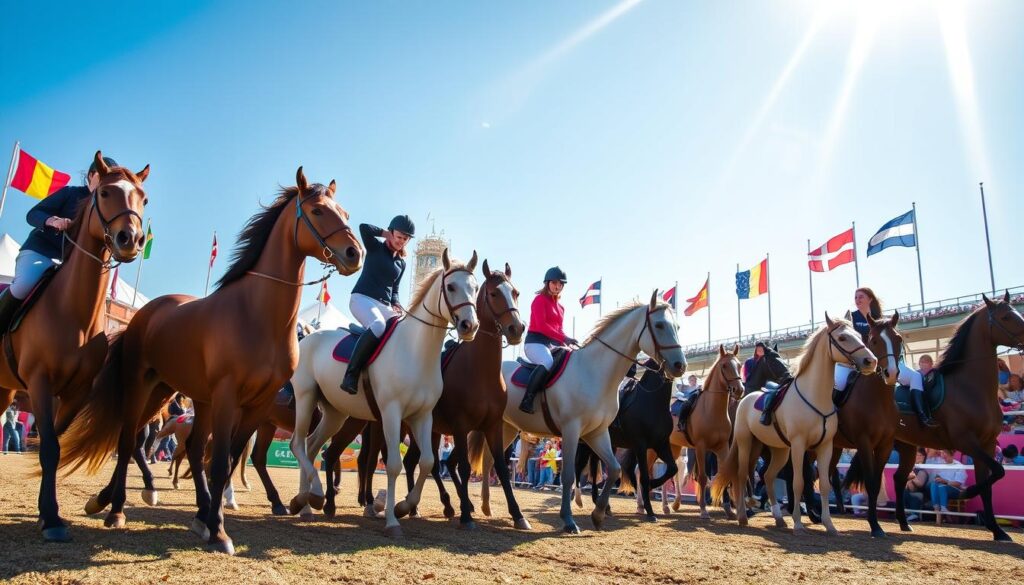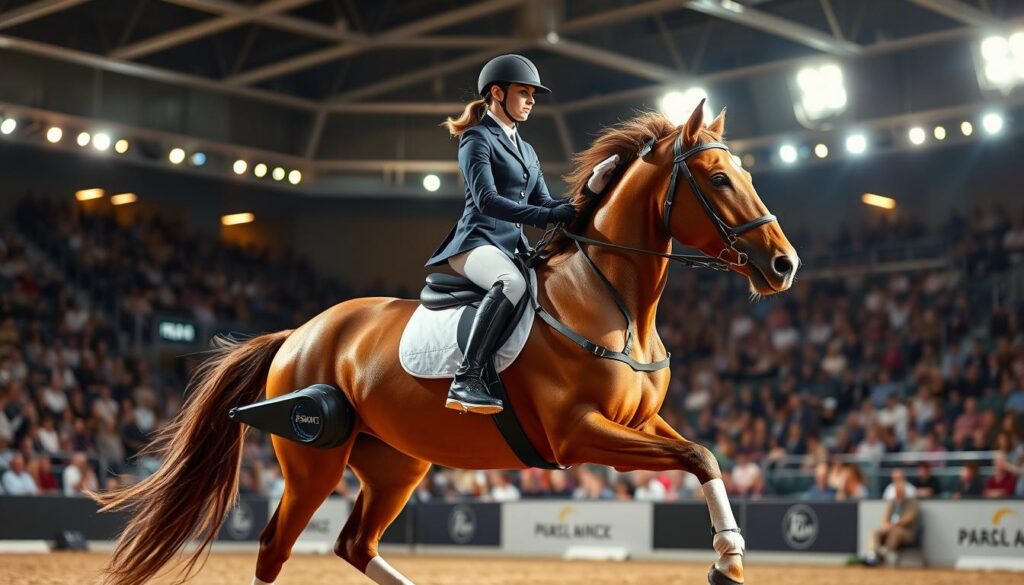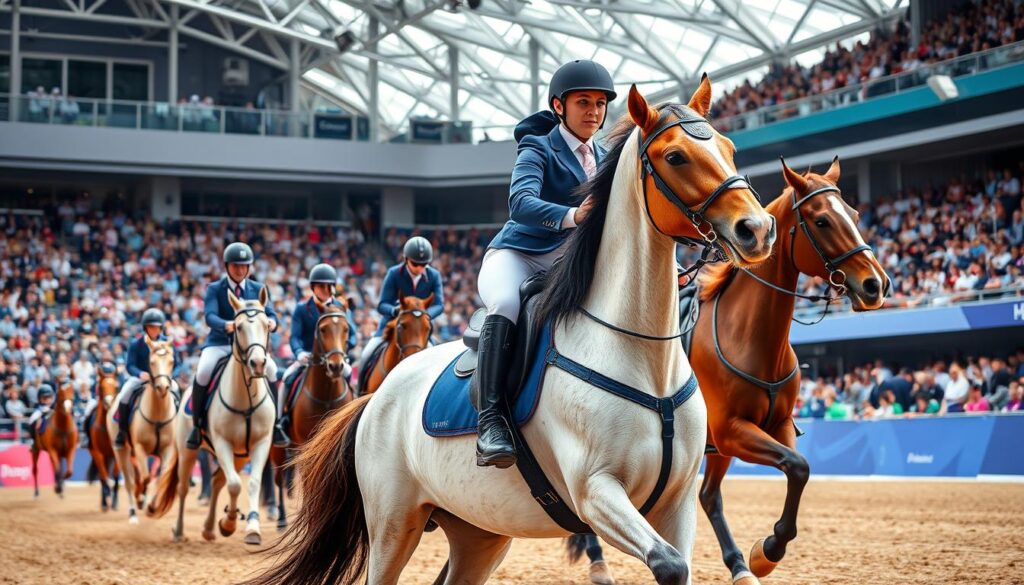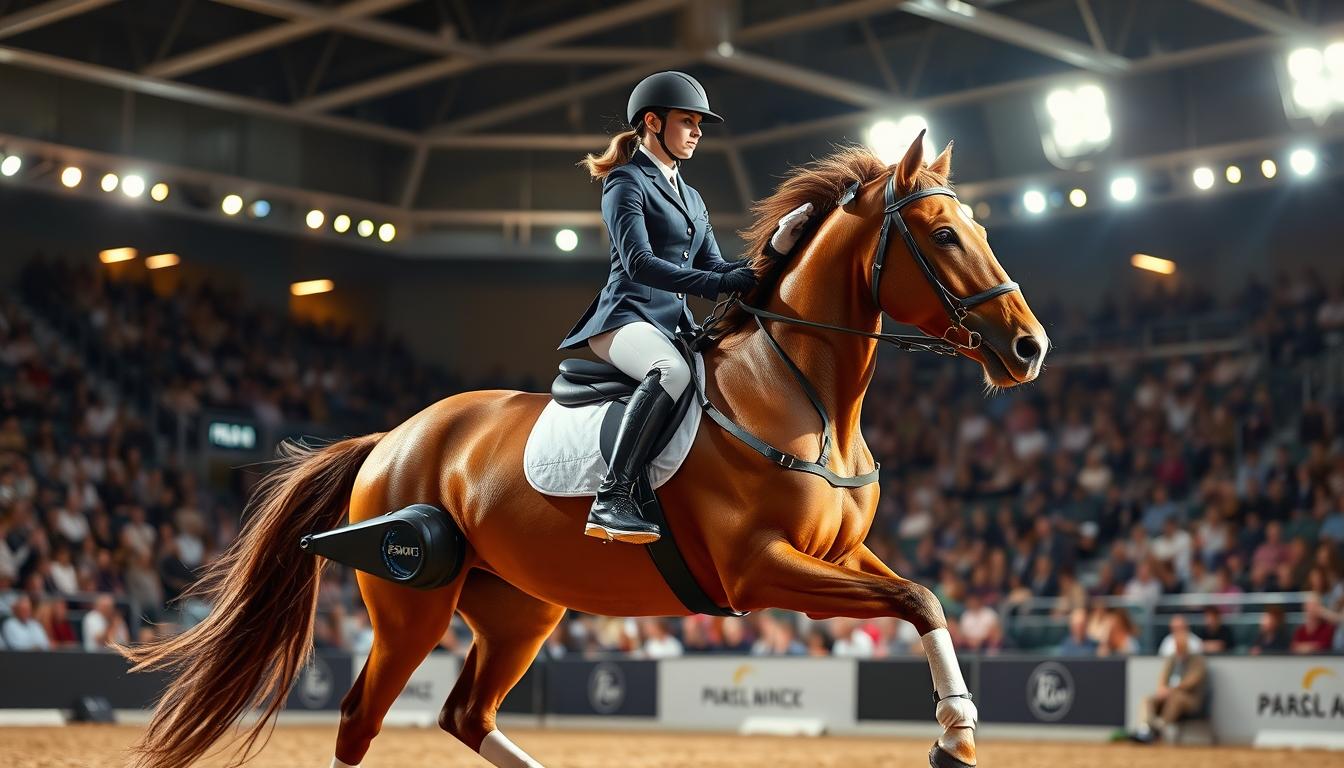Get ready to be amazed by the world’s top para-equestrian athletes at the Equestrian Paralympics 2024. This guide will give you a close look at this major event. It covers the history, events, and stories that make it a special event.
The Equestrian Paralympics 2024 will show off the skills and spirit of athletes facing physical challenges. It’s perfect for fans and newcomers to Paralympic equestrian sports. This guide will take you on an inspiring journey with these amazing athletes.

A diverse group of equestrian riders in adaptive riding gear, competing in a vibrant outdoor arena, with majestic horses in various colors, displaying dynamic poses and athleticism, surrounded by cheering spectators and colorful flags representing different countries, under a bright blue sky with sunlight streaming down.
Key Takeaways
- Discover the captivating world of para-equestrian sports and the Equestrian Paralympics 2024
- Explore the history, evolution, and exciting events of the Equestrian Paralympics
- Understand the classifications, rules, and regulations that govern para-dressage competitions
- Learn about the selection and training process for Paralympic equine athletes
- Uncover the latest adaptive technologies and assistive equipment used in para-equestrian events
Explore the Equestrian Paralympics 2024
The Equestrian Paralympics is a global event that highlights athletes with physical disabilities. It started small but has grown into a big event loved by people all over the world.
What is the Equestrian Paralympics?
This event is part of the Paralympic Games, focusing on equestrian sports like paralympic dressage. It lets athletes with different physical challenges compete in adaptive riding and therapeutic horsemanship.
History and Evolution of the Para-Equestrian Events
The Equestrian Paralympics started in the 1950s in the UK. Since then, it has become a worldwide event. The equestrian paralympics 2024 will show how the sport has grown and the athletes’ strength.
Now, the Equestrian Paralympics includes dressage, driving, and vaulting for various abilities. New technologies and a better classification system have made the competition fair for everyone.
“The Equestrian Paralympics is a true testament to the power of the human spirit and the transformative potential of the horse-human partnership.”
Understanding Para-Dressage
The Paralympics feature para-dressage, a special type of dressage for riders with physical disabilities. It lets them show off their riding skills and connect with their horses. Let’s explore the grades and classifications that make para-dressage unique.
Grades and Classifications in Para-Dressage
Riders in para-dressage are sorted into grades based on their physical abilities. Grades go from I (most impaired) to V (least impaired). This system makes sure everyone competes fairly.
Each rider’s abilities are carefully checked. This includes muscle strength, movement range, and coordination. This helps put riders in the right grade, keeping the competition fair and true to the Paralympic spirit.
Rules and Regulations of Para-Dressage
Para-dressage has the same basic rules as regular dressage but with some changes for disabled riders. Riders use special saddles and reins, and can use assistive devices like voice commands or electrical stimulation to communicate with their horses.
There’s also a special scoring system that considers the rider’s disability. This way, the focus is on the rider’s riding skills, not their physical challenges. It creates a supportive space for disabled equestrians to shine and inspire others.

A vibrant, dynamic scene of an elegantly performing horse and rider in a para-dressage competition, showcasing unique adaptive riding equipment, surrounded by an enthusiastic audience under bright stadium lights, detailed textures of the horse’s coat and the rider’s specialized attire, capturing the grace and precision of the movement.
“Para-dressage is not just about the sport, but about overcoming challenges, celebrating differences, and proving that with determination and passion, anything is possible.”
Preparing for the Equestrian Paralympics 2024
The journey to the Equestrian Paralympics 2024 is long and demanding. Paralympic equestrian athletes must work hard, train well, and go through a tough selection process. This process checks their skills and abilities.
Riders need to improve their adaptive riding and therapeutic horsemanship skills. They should practice a lot, work with a good coach, and build a strong bond with their horses. By getting better at para-dressage and other Paralympic equestrian events, riders show their talent and hard work.
Riders also need to take part in qualifying competitions. These events help riders earn points for their national team and gain experience under pressure. It’s important to know the rules of Paralympic equestrian events well.
The last step is a tough selection process. Experts look at each rider’s physical and mental strength, and overall performance. Only the best Paralympic equestrian athletes will get to go to the equestrian Paralympics 2024.
The road to the equestrian Paralympics 2024 is tough, but the benefits are huge. It’s a chance to celebrate human strength and the beauty of horse riding.
Equine Athletes: Selecting and Training for the Paralympics
The Equestrian Paralympics show the amazing partnership between humans and horses. Riders in these top events need their horses to perform amazingly in paralympic dressage. This shows the strong bond and special training needed to win.
Choosing the Right Paralympic Horse
Finding the right Paralympic horse takes a lot of thought. Riders look at the horse’s mood, how quick it responds, and if it can adjust to adaptive riding. Horses for these events are great at therapeutic horsemanship and equine-assisted therapy. They are patient, calm, and have a deep connection with their riders.
Training and Conditioning for Paralympic Equestrian Events
Getting a horse ready for the Paralympics takes a lot of hard work. Riders and coaches focus on improving the horse’s moves, balance, and quickness. They make sure the horse can handle the competition’s pressure. This training boosts the horse’s physical skills and makes the bond between rider and horse stronger.
“The partnership between a rider and their horse is the heart and soul of Paralympic equestrian. It’s a relationship built on trust, communication, and unwavering dedication.”
With careful selection and hard training, the horses in the Equestrian Paralympics become true champions. They show the spirit of sportsmanship and the strength of the human-animal bond.

A dynamic scene of a Paralympic equestrian event, showcasing a diverse group of riders with disabilities skillfully competing on beautifully groomed horses, set against a backdrop of an enthusiastic crowd in a modern stadium, capturing the spirit of determination and athleticism, vibrant colors highlighting the riders’ adaptive gear and the horses’ elegant movements.
Equestrian Paralympics 2024 2024: Qualifying and Selection Criteria
The path to the Equestrian Paralympics 2024 is filled with tough rules and selection. Riders aiming for the Paralympics must meet high standards. This ensures only the best riders compete on the world stage.
To make it to the Equestrian Paralympics 2024, riders must first get on their national team. They do this by winning trials and showing their skills and horsemanship. These trials follow the rules of Paralympic equestrian events.
After joining their national team, riders must meet the IPC and FEI’s rules. They need to score well in adaptive riding competitions and stay excellent throughout. This is how they qualify.
The selection is very competitive. Disabled equestrians from all over the world compete for a few spots. Riders must show their skills, adapt to different horses, and be strong against the challenges of the equestrian paralympics 2024.
| Qualification Criteria | Selection Criteria |
|---|---|
| Achieve minimum performance scores in recognized adaptive riding competitionsMaintain consistent level of excellence throughout qualification periodComply with IPC and FEI rules and regulations | Demonstrate exceptional riding skills and horsemanshipAdapt to various horses during competitive trialsExhibit resilience and determination in the face of challenges |
“The Equestrian Paralympics 2024 is a true test of not only our riding abilities, but also our mental fortitude and adaptability. It’s a privilege to represent our countries on this global stage.”
Adaptive Equipment and Assistive Technologies
In the world of paralympic horseback riding, adaptive equipment and assistive technologies are key. They help riders with disabilities excel in equine-assisted therapy and therapeutic horsemanship. These tools are changing the game for disabled equestrians.
Saddles, Reins, and Other Adaptive Tack
Specialized saddles are crucial for Paralympic equestrian athletes. They offer extra support and stability. Riders with physical challenges find these saddles very helpful.
Other important tools include special reins and tack. These help riders control and balance easily. Things like adjustable stirrups and mounting blocks make the sport more accessible for everyone.
Technological Advancements in Para-Equestrian Sports
| Assistive Technology | Application in Para-Equestrian Sports |
|---|---|
| Wearable Sensors | Monitoring rider performance and horse-rider interaction |
| Voice-Controlled Interfaces | Enabling riders to communicate with their equine partners |
| Robotic Assistance Systems | Aiding with mounting, dismounting, and in-saddle stability |
Recent years have seen big changes in paralympic horseback riding. Now, we have wearable sensors, voice-controlled interfaces, and robotic systems. These are changing how riders with disabilities interact with their horses and take part in the sport.
“Adaptive equipment and assistive technologies have been game-changers for disabled equestrians, unlocking new possibilities and empowering them to excel in equine-assisted therapy and therapeutic horsemanship.”
As the Equestrian Paralympics 2024 gets closer, we’ll see more progress in these tools. They will support and boost the performance of Paralympic equestrian athletes. This will lead to even more achievements in the sport.
Venues and Facilities for the 2024 Paralympics
The world is excited for the Equestrian Paralympics 2024. Everyone is looking forward to the amazing venues and facilities for these top athletes. The Equestrian events will be held in a top-notch equestrian complex. This complex is designed for the special needs of Paralympic equestrian events, adaptive riding, and therapeutic horsemanship.
The main arena is a huge, world-class place with the newest equestrian features. It’s made for the equestrian paralympics 2024. The arena has:
- Carefully groomed and maintained footing, ensuring a safe and secure surface for the horses and riders
- Ample seating and spectator areas, allowing fans to witness the thrilling competitions
- Fully accessible facilities, including ramps, elevators, and assistive devices, catering to the needs of all Paralympic athletes
- State-of-the-art stabling and veterinary facilities, ensuring the well-being of the equine athletes
Around the main arena, the Equestrian Complex has more amenities and training areas. These include:
- Warm-up arenas for athletes to prepare before their events
- Dedicated therapy and rehabilitation centers, supporting the unique needs of Paralympic equestrian events
- Specialized equipment and technology for adaptive riding and therapeutic horsemanship
- Comfortable accommodations and dining options for athletes, coaches, and spectators
The Equestrian Complex for the 2024 Paralympics has unmatched facilities and a focus on accessibility. It will be a special place for the world’s most inspiring equestrian paralympics 2024 athletes. It shows the power of determination and how sports can change lives.
Meet the Para-Equestrian Superstars
The 2024 Equestrian Paralympics will highlight the amazing talents and stories of top para-equestrian athletes. These athletes have faced huge challenges to become champions. They show us the strength of determination, resilience, and how adaptive riding changes lives.
Inspiring Stories of Paralympic Equestrian Athletes
Roxanne Trunnell is a two-time Paralympic gold medalist known for her amazing skills in dressage. She was born with a condition that affects her mobility. Yet, she has overcome this to show that disability doesn’t stop you from being great. Her hard work and connection with her horse inspire many para-equestrian athletes worldwide.
Natalie Dear is another inspiring story. She lost her leg in a motorcycle accident but didn’t let it stop her. Natalie’s journey to the Paralympics is filled with spirit, using new technologies, and showing what disabled equestrians can do. Her success has inspired others and promoted the Paralympic movement’s inclusivity.
FAQ
What is the Equestrian Paralympics?
The Equestrian Paralympics is a global event for athletes with physical disabilities. It includes various equestrian sports. The main event is para-dressage, where riders compete in events suited to their abilities.
What is para-dressage?
Para-dressage is a key part of the Equestrian Paralympics. It highlights the skill and bond between riders with physical disabilities and their horses. They perform complex dressage routines together.
How are athletes classified in para-dressage?
Athletes in para-dressage are sorted by their physical impairment level. This puts them in one of five grades, from Grade I (most impaired) to Grade V (least impaired). This system makes sure the competition is fair.
What are the key rules and regulations in para-dressage?
The rules in para-dressage focus on safety and fairness. They cover things like allowed adaptive gear, aids, arena size, and how riders are scored.
How do riders and horses qualify for the Equestrian Paralympics?
To qualify for the Paralympics, riders and horses must meet strict standards. They need to score enough points and follow their country’s selection rules.
What types of adaptive equipment are used in para-equestrian sports?
Athletes use special gear like customized saddles and reins. This equipment helps riders with physical disabilities control their horses during competitions.
Can you tell me about some inspiring para-equestrian athletes?
The Equestrian Paralympics features many inspiring athletes. Stars like Lee Pearson from Britain and Roxanne Trunnell from the US have won many gold medals. They’ve overcome big challenges to succeed in their sport.

